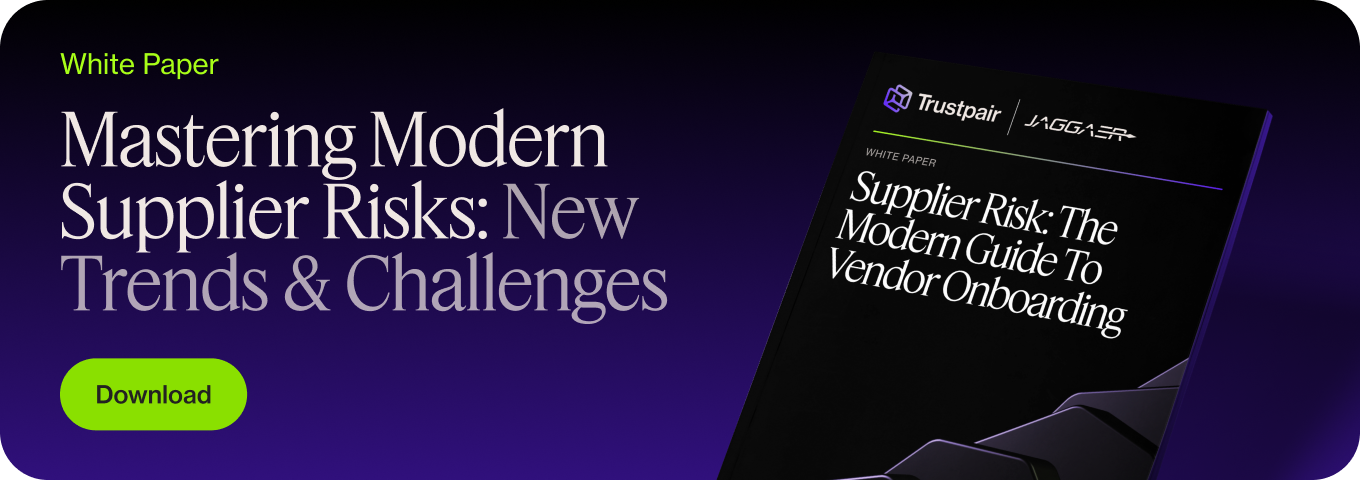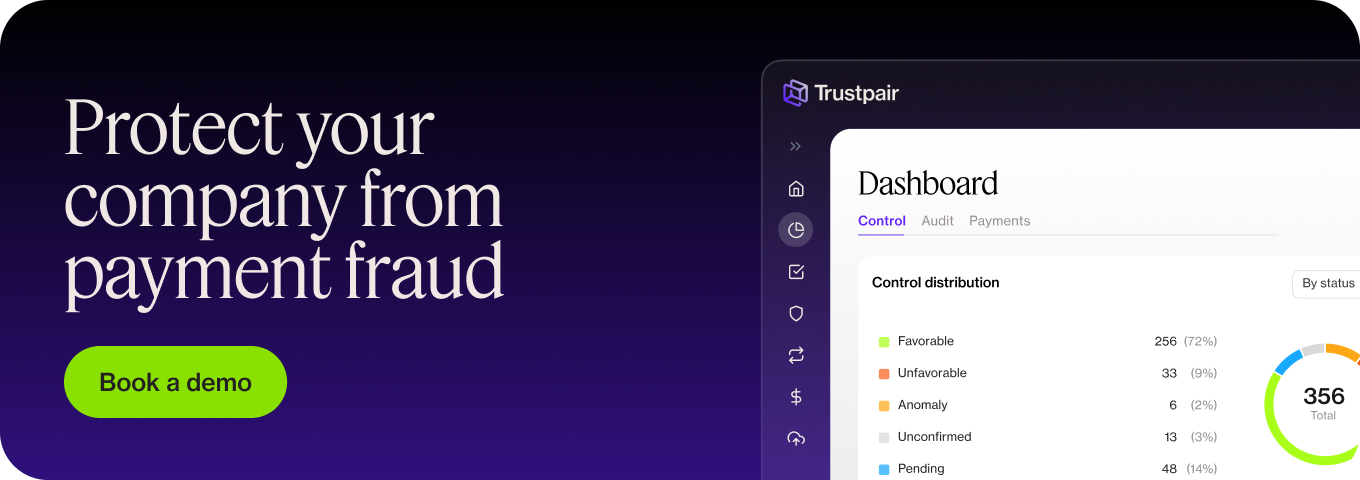Vendors, partners… Third parties are at the core of B2B organizations’ operations. It’s crucial to maintain good relationships to maintain business, while also minding the possible third-party risks. From financial fraud to reputational risk, many risks can have a big impact on organizations. That’s where third-party risk management comes into play. Read on to find out how your organization can implement a solid third-party risk management strategy and what it’s all about!
Trustpair is a best-in-class vendor fraud prevention system: we deliver clear assessments of your vendors and block the financial effects of fraud. Request a demo to learn more!
What is a third-party risk?
Dealing with third parties is a necessary part of business, but organizations need to know exactly who they are dealing with. Without this knowledge, it is easy to fall foul of compliance and regulatory requirements. Not to mention companies may be putting themselves at risk of fraud and all the associated financial and reputational risk that goes with it.
Third parties can pose a variety of risks, including the risk of failure and non-compliance with corporate social responsibilities such as human rights and the environment. Deloitte’s Third-Party Risk Management (TPRM) Global Survey 2020 says, for example, that, of their respondents, “almost half of organizations (46%) surveyed believe the financial impact of a failure by a third party or subcontractor has at least doubled over the last five years, with a tenfold increase for one in five. That financial impact includes fines, direct compensation costs, and lost revenue”.
What are the types of third-party risks?
There are six main types of risk to be aware of:
- Cyber risks. In an increasingly cyber environment, fraudsters are getting more sophisticated and dangerous. They can easily hack one of your vendors and send a fake invoice for example. Building robust cybersecurity safeguards is critical for businesses.
- Compliance risks. Organizations have to comply with many international regulations (Nacha, SOX, etc). If one of the third parties your business works with isn’t compliant – even if you’re not aware – it might tarnish your reputation and activity.
- Reputational risks. Third parties can easily damage a partner’s image, by not respecting human rights or standard work conditions. PR best practices should be implemented to avoid this type of risk.
- Financial risks. Working with third parties means needing them – for production, services, etc -. This means there’s a direct risk if one of these vendors can’t deliver on time, for example, endangering sales and the overall activity.
- Operational risks. As mentioned above, it’s easy to develop a dependency on vendors, meaning you can easily be left in the lurch if one of your key partners can’t deliver on time. This can mean operational disruptions and financial loss in the long run.
A focus on cyber fraud, an emerging and critical risk factor
As mentioned above, businesses are increasingly open to the risk of cyber fraud. Companies and organizations that do not operate with the right processes in place expose themselves and other parties to fraud risk. There are various ways in which criminals can exploit cyber weaknesses:
- Hacking into systems – passwords and financial information can be stolen.
- Business email compromise – this includes CEO fraud, phishing, and other scams that involve taking over company email accounts and impersonating personnel to divert funds.
- Malicious software – fraudsters can hijack files and hold them to ransom.
- Denial of service (DoS) attacks against websites – payments are often required to end the disruption to a service.
More and more often, cyber criminals use third parties to perpetrate cyber fraud. Either by hacking into their systems and impersonating them or by infiltrating communications, etc.
Risks are often compounded in certain situations. So, how should companies assess and manage third-party risk?
Have a larger risk management framework
A robust risk management framework is essential for organizations to identify, assess, and mitigate potential risks effectively. It provides a structured approach to understanding and managing uncertainties that could impact an organization’s objectives. Key components of a strong risk management framework include:
- risk identification processes
- risk assessment methodologies
- risk mitigation strategies
- continuous monitoring and review mechanisms
Additionally, it should foster a culture of risk awareness across all levels of the organization, ensuring that risk management is integrated into daily operations and strategic decision-making. This framework helps organizations to be proactive rather than reactive, particularly in the context large B2B fraud attempts through AI for example.
What is third-party risk management?
Third-party risk management, or TPRM, is also given various other names including supplier risk management, supply chain risk management, vendor risk management, or vendor management. TPRM covers all kinds of third parties and all the risks that they can create.
It is used by organizations to help identify and reduce the risks that relate to using third parties in the business. Companies that fail to fully investigate and protect themselves against third-party risk also compromise their compliance with the regulatory environment. While some aspects of third-party risk management can depend on the sector a company is operating in and its associated regulatory requirements, many best-practice ways of working can be applied to all.
What are the key steps of third-party risk management?
Each business has its’ own best practices and processes. However, there are some key steps in third-party risk management:
- Identification of the business need for a new third party. This could be a vendor, a service provider, a partner, etc.
- Due diligence of possible vendors. This should include different aspects like cybersecurity, financial stability, compliance with international regulations, etc.
- Third-party selection and choice. This decision should be based on the objective criteria investigated during the due diligence phase.
- Third-party risk assessment. Once you’ve selected a partner, send him a detailed questionnaire to identify possible risks and plan for them accordingly. This questionnaire should be adapted to the type of business and industry.
- Contract and onboarding process. Make sure you sign a robust contract with specific conditions and clauses. This will open the vendor onboarding phase, which is crucial to build a long-lasting business relationship.
- Ongoing risk monitoring. It’s important to frequently review your risk framework and criteria to make sure they’re up-to-date.
Vendor onboarding is a key step of third-party risk management. Download our latest white paper to learn how to secure it!
Risk management best practice
Education first, robust systems, and the right software will all help in managing risk. As the Deloitte report notes, “the risk landscape changed significantly with COVID-19 impacting organizations globally and across industries… It is now clearer than ever how important it is to prioritize TPRM”.
Companies should educate employees on what constitutes fraud and how fraudsters work. They should be cognisant of the main scams and know how to deal with any concerns they may have quickly. The right systems and software in place will help with this enormously. The PwC Global Economic Crime and Fraud Survey 2020 found that “companies that have a dedicated fraud program in place generally spent less (relative to revenue) on response, remediation and fines”.
Manage your financial third-party risks with Trustpair
Trustpair is the leading company in third-party risk management. Our machine learning-based solution will analyze, monitor, and verify third-party data. The solution can integrate into existing technical environments (TMS, ERP, etc).
Our system offers automated processes that reduce third-party fraud risk and adds extra steps to make the procure-to-pay (P2P) process more secure. Bank details of third parties are systematically checked to ensure that they match the vendor and your organization isn’t paying a cyber attacker or a fraudster. We give peace of mind and free up valuable employee time, allowing them to focus on more productive tasks. We also reduce the risk of human error and exposure to corruption or bribery.
To find out more about how our software can help with your third-party risk management, request a demo!
Key Takeaways:
- Third-party risk management (TPRM) helps companies understand and mitigate the risk of working with third parties. This includes identifying risks, assessing them, and having a plan in place in case they occur.
- Third-party risks include cyber, financial, operational, compliance, and reputational risks. Each business has its’ own set of risks, depending on internal processes, industry, size of the organization, etc.
- It is vital to have the right TPRM systems and software in place for sustainable business operations.
- Trustpair TPRM software offers solutions for extra security and peace of mind. We ensure vendor compliance with regulatory standards and monitor vendor data to make sure there isn’t any suspicious change or financial transaction.






